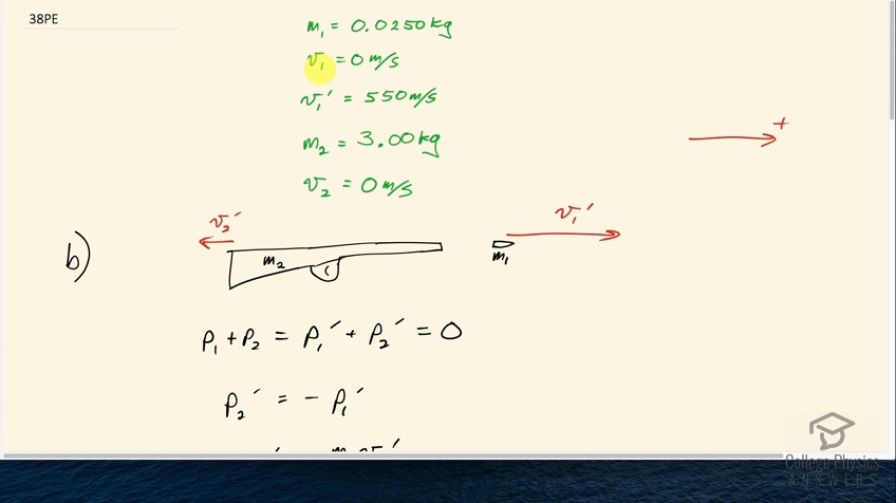Question
A 0.0250-kg bullet is accelerated from rest to a speed of 550 m/s in a 3.00-kg rifle. The pain of the rifle’s kick is much worse if you hold the gun loosely a few centimeters from your shoulder rather than holding it tightly against your shoulder. (a) Calculate the recoil velocity of the rifle if it is held loosely away from the shoulder. (b) How much kinetic energy does the rifle gain? (c) What is the recoil velocity if the rifle is held tightly against the shoulder, making the effective mass 28.0 kg? (d) How much kinetic energy is transferred to the rifle- shoulder combination? The pain is related to the amount of kinetic energy, which is significantly less in this latter situation. (e) Calculate the momentum of a 110-kg football player running at 8.00 m/s. Compare the player’s momentum with the momentum of a hard-thrown 0.410-kg football that has a speed of 25.0 m/s. Discuss its relationship to this problem.
Final Answer
- ,
Solution video
OpenStax College Physics for AP® Courses, Chapter 8, Problem 38 (Problems & Exercises)

vote with a rating of
votes with an average rating of
.
Calculator Screenshots
Video Transcript
This is College Physics Answers with Shaun Dychko. A 0.025 kilogram mass bullet is shot from the end of a rifle; initially, it has a speed of zero and afterwards, it has a speed of 550 meters per second— we are taking positive to the right. This rifle, body and barrel has mass of 3.0 kilograms and initially, it also is not moving. And in part (b) or (a) I should say, we have to figure out what is the recoil velocity of the rifle? So the total momentum initially of the bullet and rifle system equals the total momentum that it has after the bullet is fired and that total is going to be zero because initially neither of them are moving and so we can solve for P 2 prime which is going to contain the factor v 2 prime which is what we want to find— this recoil velocity— this P 2 prime is gonna be negative P 1 prime because we can subtract P 1 prime from both sides here. And then substitute in m 2 times v 2 prime in place of P 2 prime and negative m 1v 1 prime in place of P 1 prime and then divide both sides by m 2 to solve for v 2 prime. So v 2 prime—the recoil velocity of the rifle— is gonna be negative mass of the bullet times the bullet's firing velocity prime divided by m 2. So that's negative 0.0250 kilograms times 550 meters per second divided by 3.00 kilograms which is negative 4.58 meters per second. In part (b), we are asked what is the change in kinetic energy of the rifle? Well initially, it has no kinetic energy so this change is just going to be whatever final kinetic energy it has. So that's one-half times 3.00 kilograms times its recoil velocity of negative 4.5833 meters per second squared which is 31.5 joules. Part (c) says suppose the butt of the rifle is held firmly against the shooter's shoulder giving this rifle an effective mass of 28.0 kilograms, what would its recoil velocity be then? So it's the same formula: v 2 prime is negative m 1v 1 prime over m 2 but m 2 instead of being 3.00 kilograms is now 28.0. And so this is the same number that's on top as for part (a) but we now have 28.0 kilograms on the bottom giving a recoil velocity of negative 0.491 meters per second. And then part (d) says what is the change in kinetic energy of this combination? So that's one-half times the mass of 28.0 kilograms times this new recoil velocity and that gives 3.38 joules. And part (e), we are meant to find the momentum of this football player which is the player's mass times their velocity, 110 kilograms times 8.00 meters per second and that is 880 kilogram meters per second and then compare that to the momentum of a hard thrown ball which is 0.410 kilograms going at 25.0 meters per second which is 10.3 kilogram meters per second. And it asks us how does this relate to the question and the connection is not... particularly clear but I think what they are getting at, throughout this question, is that when you have a more massive system then you are going to be reducing its speed keeping momentum roughly the same. And so in part (c) for example, we increased the effective mass of the rifle from 3 to up to 28 kilograms and in so doing reduced the recoil velocity significantly and then really reduced the kinetic energy very significantly. The proportion by which the mass was increased is not the proportion by which the kinetic energy decreases; in fact, the kinetic energy decreases by a much larger proportion since kinetic energy depends on velocity squared. Okay! So yeah the connection is meant to be that with momentum being the same, more massive things have a reduction in speed and since pain experienced in getting hit by the recoil of the rifle is in proportion to the rifle's kinetic energy, decreasing speed has a big effect on decreasing the pain of the recoil.

